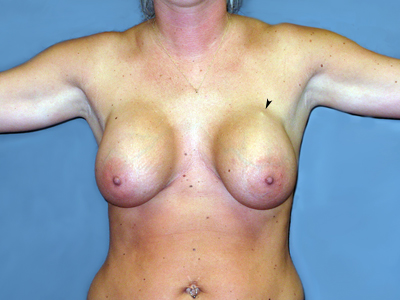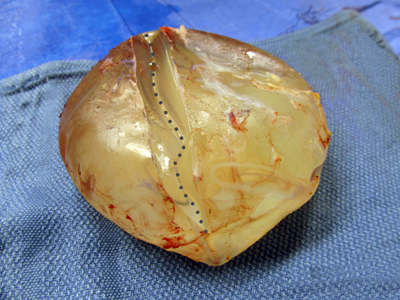Capsular contracture is the most common complication following breast augmentation. Reported capsular contracture rates range from a few percent to much more significant numbers depending upon the criteria used for evaluation and inclusion. An average rate is probably about 10%. Allergan’s Core Study for round silicone gel breast implants reported the risk of severe capsular contracture (Baker Grade III and IV) for primary breast augmentation to be 16% during the first seven years. Capsular contracture may occur soon after surgery or much later, may occur in one breast or both breasts, may occur with saline or silicone gel breast implants, and may occur if the implants are over the muscle or under the muscle. Although a few approaches may reduce the risk, every woman who has breast implants is at risk for capsular contracture.
The breast implant shell is constructed if an essentially non-reactive and inert silicone elastomer. Despite this, from the viewpoint of the human body, the breast implant is a foreign object and material. The healing response to such a foreign body results in the formation of a very thin layer of fibrous (scar) tissue around the entire implant. This thin layer that envelops the implant is referred to as the “capsule”. Such a capsule forms around every breast implant whether it is placed above or below the muscle.
In the ideal situation this capsule would remain thin, pliable, and distensible. Unfortunately however, there are times when it does not. This capsule, like all scar tissue, can contract. When it does so, the capsule shrinks in size compressing the implant inside of it. In doing so, the contracting capsule naturally tends to assume a shape that minimizes the surface area-to-volume ratio (a sphere).
A round breast implant is normally discoid in profile. When subjected to a capsular contracture, the implant is forced to assume a more spherical shape as the contracture progressively worsens. As the implant is forced into this shape, the shell must fold upon in itself. If the capsular contracture is progressive, the capsule will contract until the compressive forces of the contracture are unable to squeeze the contents of the implant any further. The resulting shape of the contracted implant is rather spherical, and the breast may often take on this shape as well. As a capsular contracture worsens, the size, shape, and/or position of the involved breast may change.
This woman has subglandular saline implants with a Grade III capsular contracture. Notice the distortion and asymmetry of her breast shape; a somewhat elongated and cylindrical appearance has replaced the more natural round fullness.
The visibility of the contracture is increased when she raises her arms to the side. The arrow points to a visible lump in the surface contour of her breast where the implant is folded inside the contracted capsule. When the implant shell is folded over on itself, a point forms along the edge of the implant; it is this point that is seen poking outward because the implants are above the muscle.
Unfortunately, there is no definitive medication or procedure to prevent a capsular contracture form forming.
During the preoperative consultation, I frequently speak about capsular contracture. It is important for women considering breast augmentation surgery to have some understanding of what capsular contracture is, how it forms, what treatment options exist, and that in some respects there is little that can be done to really prevent it. The discussion is not particularly complex, but I often feel as if women do not have the clearest understanding of what a contracture really looks like. Some women may have come across pictures of capsular contracture in their research about breast augmentation. But, it is usually only the surgeon who gets to see the contracture on the inside. If patients were able to actually visualize the contracture, this would certainly help to improve their understanding.
Capsular Contracture of a Silicone Gel-filled Breast Implant
And that is the real benefit of the photographs below. The photographs shown here really help illustrate a capsular contracture. The implants were removed from a woman who had grade III capsular contractures around her subglandular silicone gel breast implants. The first image shows the entire capsule was removed intact, with the breast implant still inside. In this particular situation, the capsule is particularly thin and transparent. Capsules can have a wide array of appearances; they can be thicker, more translucent, sometimes almost opaque, and can even be calcified in certain situations.
The transparency of this capsule allows you to see that the implant has been compressed, and as a result the shell has folded in on itself. The black arrows mark the line of folding.
A second view shows where the implant shell has been forced to ripple as a result of the contracture. The black arrows delineate where the shell is folded in on itself. The blue arrows mark locations of implant shell wrinkling.
In this third picture, when the capsule is opened and the contracture partially released, the deep groove formed by the inward folding of the implant shell is seen. The deepest part of the fold is marked by the dotted line.
This fourth picture illustrates the natural size and shape of this breast implant (275cc, removed from the left breast) in comparison to the size and shape of the implant inside a grade III capsular contracture (275cc, removed from the right breast).
The black arrows in the photograph below show a crease in the breast implant shell as a result of it having been folded over inside the capsular contracture.
It is this folding of breast implant shells that can lead to premature implant failure. Neither of the breast implants in the case above were failed. However, a significant fold in the breast implant shell causes a point to form at the implant edge. Slight movements of the implant and implant shell, occurring at this point, produce added stress within the shell leading to loss of shell integrity and a small hole. This (“fold flaw failure”) occurs to implants that are folded within capsular contractures, or implants that are improperly sized (when the implant diameter is too large) for the breast pocket.





Trackbacks/Pingbacks